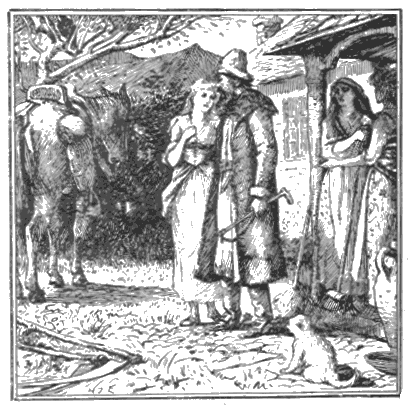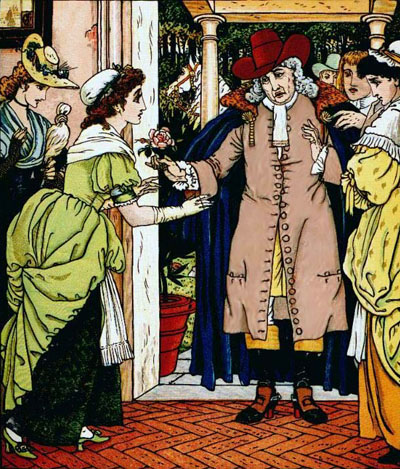Not that this theory is necessarily true, or that if it is, it is the only way children perceive fairy tales. At most it could be one of many.
But in Beauty and the Beast there is almost this same distinction. Now, in Villeneuve and Beaument's stories, the Beast is really a perfect gentleman in disguise, but in older tales that distinction is less apparant. Many times their behavior is more animalistic, and Beauty only falls in love once she has seen the true form of the Prince. Cocteau's Beast's hands smoke after coming back from a hunt. And then there's of course the Disney Beast, who has anger to match his beastly appearance.
Illustration from Andrew Lang's The Blue Fairy Book, by H.G. Ford and G. P. Jacomb Hood
The story we assume to be written as a comfort to girls given away in marriage to strange, often older, men, who may appear very much to be monstrous to a young girl. Yet the father figure is often painted to be good and kind, even though he ultimately allows his daughter to go live with a monster. It would be unlikely for a young girl to perceive her future mate as a monster and yet only have loving feelings for the father who forced her into the union.
Illustration by Walter Crane
Now, the father does play different roles in different versions. But what if the father and Beast were different projections of perceptions of males to young females? In a time when males were given total authority over their wives and daughters, they would often take advantage of their power. A girl may fear her father's wrath for disobeying like she might fear a wild and powerful beast, yet also have a good relationship with her father at times. Or a suitor may flatter, yet also be a threat to her independance.
It may seem disturbing to connect the father and suitor to the same person, but critics have wondered if Donkeyskin's father was really the same person as the prince. As a friend of mine pointed out after seeing the play "Secret in the Wings," the prince only falls in love with her for her beauty-the same reason her father wanted to marry her before. And in society, especially Victorian, the husband would ultimately have the same degree of control over his wife that her father formerly had.
Now, the father does play different roles in different versions. But what if the father and Beast were different projections of perceptions of males to young females? In a time when males were given total authority over their wives and daughters, they would often take advantage of their power. A girl may fear her father's wrath for disobeying like she might fear a wild and powerful beast, yet also have a good relationship with her father at times. Or a suitor may flatter, yet also be a threat to her independance.
It may seem disturbing to connect the father and suitor to the same person, but critics have wondered if Donkeyskin's father was really the same person as the prince. As a friend of mine pointed out after seeing the play "Secret in the Wings," the prince only falls in love with her for her beauty-the same reason her father wanted to marry her before. And in society, especially Victorian, the husband would ultimately have the same degree of control over his wife that her father formerly had.
Charles Lamb illustration
People may have written on this subject before-I'm not aware if they have, not that my knowledge of fairy tales is all-encompassing. But note that this is just a thought that crossed my head, not a hard and fast theory I have, just something interesting to contemplate in the light of other fairy tales and how they have been analyzed.




You may find the first version ever of this tale (in fact probably the first version ever of an oral wonder tale) interesting: Sweden ca. 1612. (Its very existence incidentally disproves Bottigheimer's theory of Straparola etc.). There is an English translation on www.academia.edu/MeyerOle
ReplyDeleteHmm, the link didn't go through for me. Thanks though! There are definitely versions of fairy tales that existed prior to Straparola and Basile, although they aren't as common, and sometimes it gets sticky because although they are stories that evolved into the fairy tales we know, they may have been a different genre before.
DeleteI wrote more fully about my responses to Bottigheimer here: http://talesoffaerie.blogspot.com/2012/02/ruth-bottigheimers-new-history-of-fairy.html
Overall it's too bold a statement, I think, to say NO fairy tales existed prior, although I do think she's right to point out how strongly influential those Italian men were in fairy tale history, much more so than we realize